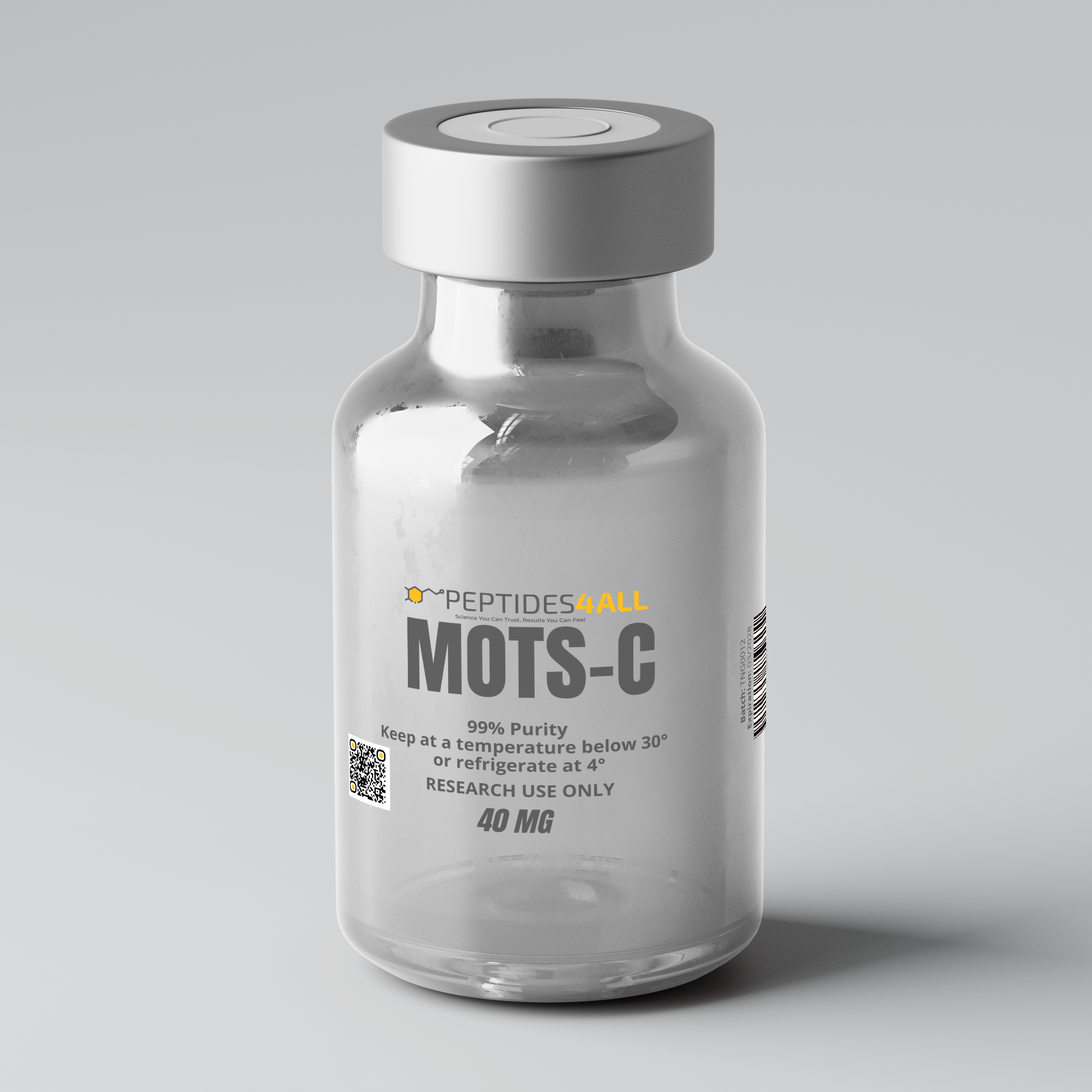PEPTIDES4ALL MOTS-C – Mitochondrial-Derived Peptide for Metabolism & Cellular Resilience
PEPTIDES4ALL MOTS-C represents a breakthrough in mitochondrial peptide research, offering new insight into the intersection of metabolism, aging, and cellular stress adaptation. MOTS-C (Mitochondrial Open Reading Frame of the 12S rRNA-c) is a naturally occurring 16-amino-acid peptide encoded by mitochondrial DNA, distinguishing it from most peptides that originate from nuclear genes. This unique genetic origin places MOTS-C at the heart of mitochondrial signaling — the intricate communication between mitochondria and the rest of the cell that governs energy production, stress response, and metabolic regulation.
Early discoveries revealed that MOTS-C functions as a metabolic regulator and cytoprotective messenger, acting through AMP-activated protein kinase (AMPK) and related pathways to promote glucose utilization, lipid metabolism, and mitochondrial efficiency. By influencing these key processes, it plays a critical role in cellular resilience, helping tissues adapt to metabolic stress and maintain homeostasis under adverse conditions such as overnutrition, oxidative imbalance, or aging.
Recent studies have highlighted MOTS-C’s potential to enhance insulin sensitivity, support muscle performance, modulate fat oxidation, and reduce metabolic inflammation, making it a molecule of growing interest in research related to metabolic syndrome, type 2 diabetes, obesity, and age-related decline. Moreover, its mitochondria-to-nucleus signaling behavior suggests a systemic role in coordinating adaptive gene expression — positioning MOTS-C as both a biochemical energy regulator and a molecular guardian of longevity.
With its exceptional purity and stability, PEPTIDES4ALL MOTS-C provides researchers with a high-fidelity tool for exploring mitochondrial dynamics, metabolic optimization, and cellular protection mechanisms, furthering the understanding of how mitochondrial peptides influence whole-body energy balance and healthy aging.
Scientific Evidence & Research Findings
-
Improved Glucose Utilization & Insulin Sensitivity – MOTS-C activates the AMPK pathway, promoting glucose uptake in muscle and improving insulin sensitivity in high-fat diet models. https://www.sciencedirect.com/science/article/pii/S1550413115000613
-
Mitochondrial Bioenergetics Support – It boosts ATP production, enhances mitochondrial respiration, and restores mitochondrial efficiency in diabetic tissues. https://www.frontiersin.org/journals/physiology/articles/10.3389/fphys.2025.1602271/full
- Fat Metabolism & Energy Homeostasis – MOTS-C modulates lipid metabolism, promotes browning of white fat, reduces fat accumulation, and helps maintain metabolic flexibility. https://translational-medicine.biomedcentral.com/articles/10.1186/s12967-023-03885-2
- Muscle Protection & Glucose Uptake – In muscle tissue, MOTS-C prevents atrophy and enhances glucose uptake via GLUT4 translocation, mediated by mitochondrial fusion mechanisms. https://www.cell.com/iscience/fulltext/S2589-0042(24)02437-4
- Pancreatic Cell Health & Anti-Senescence – MOTS-C reduced signs of cellular senescence in pancreatic islet cells and improved glucose tolerance in diabetic mouse models. https://www.nature.com/articles/s12276-025-01521-1
Key Research Benefits & Applications
-
Mitochondrial Bioenergetic Regulation: Enhances ATP production, oxidative phosphorylation, and mitochondrial efficiency, providing a robust model for studying mitochondrial signaling and cellular energy dynamics.
-
Metabolic Optimization & Insulin Sensitivity: Activates AMPK-dependent pathways to increase glucose uptake, improve insulin sensitivity, and normalize energy metabolism in models of diet-induced obesity and metabolic syndrome.
-
Fat Oxidation & Energy Homeostasis: Promotes lipid metabolism and browning of white adipose tissue, reducing fat accumulation and improving metabolic flexibility under stress or caloric excess.
-
Cytoprotection & Anti-Aging Effects: Supports cellular resilience by reducing oxidative stress, limiting inflammation, and protecting against mitochondrial dysfunction and senescence in metabolic and aging models.
-
Muscle Performance & Anti-Atrophy Support: Enhances muscle glucose uptake, mitochondrial fusion, and endurance capacity, contributing to tissue preservation and improved metabolic output.
-
Applications in Metabolic & Longevity Research: Serves as a mitochondrial-derived signaling model for exploring the molecular crosstalk between mitochondria and nucleus, uncovering therapeutic insights into aging, obesity, and metabolic resilience.
Presentation & Handling
- Form: Supplied as lyophilized peptide in sterile vial.
- Reconstitution: Use bacteriostatic water or 2% procaine; swirl gently (do not shake vigorously).
- Storage: Store at –20 °C, protected from light and moisture. After reconstitution, use according to research protocols and handle under sterile conditions.
Intended Use
For research purposes only. Must be handled in accordance with institutional protocols and ethical guidelines.
